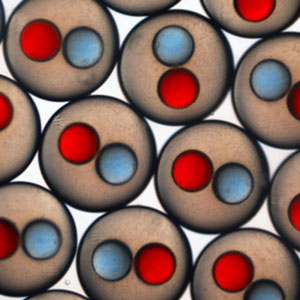| Nov 30, 2011 |
Nano meets pharma at Harvard-BASF symposium
|
|
(Nanowerk News) Experts gather this week to discuss the efficient creation and delivery of nanoscale particles of drugs.
|
|
From targeted cancer chemotherapy to the guarantee of successful organ transplants, the 21st century may prove to be the age of big ideas in medicine.
|
|
The drugs themselves, though, will be miniscule.
|
|
Experts in chemistry, applied physics, materials science, and pharmaceutical science are gathering this week for the BASF Advanced Research Initiative at Harvard University's symposium on pharmaceutical nanoformulations.
|
|
The two-day symposium, co-hosted by the Harvard School of Engineering and Applied Sciences (SEAS) and leading chemical company BASF, and held at the American Academy of Arts and Sciences in Cambridge, provides an opportunity for more than 200 leading researchers to discuss the challenges of modern medicine and the search for innovative solutions in nanotechnology.
|
 |
| Researchers at Harvard are investigating new methods of creating and delivering nanoparticles of drugs. Microfluidics and double emulsions (pictured here) hold promise in this field. (Photo by Laura Adams, Weitz Lab)
|
|
Small particles with big potential
|
|
A great deal of research in engineering and the applied sciences today involves the manipulation of materials at the nanometer scale to achieve particular physical and chemical properties.
|
|
In the realm of pharmacy science, for instance, many recently developed drug compounds are strongly hydrophobic, meaning that their molecules do not dissolve easily in water—or, therefore, in the bloodstream.
|
|
"That problem can be overcome if the drug particles are tiny enough, on the order of a few billionths of a meter," says David Weitz, Mallinckrodt Professor of Physics and Applied Physics at SEAS and co-director of the BASF Advanced Research Initiative.
|
|
The grand challenge in the field of nanoformulations involves both the creation of precisely tailored, nanoscale particles of drugs and the safe and efficient delivery of those tiny particles to their exact targets within the human body.
|
|
BASF supports researchers at SEAS and across Harvard who are exploring a variety of approaches to this problem.
|
|
"I have a vision that is inspired in part by the fact that most people say it's impossible," says Weitz. "I think we can make meaningful quantities of valuable materials using microfluidics as a fabrication strategy. There are people at BASF who believe in that, and they've been supporting work in my lab."
|
|
At the symposium, he says, "I'll try to convince people that yes, we can."
|
|
Attendees will also hear from George Whitesides, Woodford L. and Ann A. Flowers University Professor at Harvard; and David Mooney, Robert P. Pinkas Family Professor of Bioengineering at SEAS. (Whitesides and Mooney are also core faculty members at the Wyss Institute for Biologically Inspired Engineering at Harvard.)
|
|
At SEAS, Mooney has been working to develop a therapeutic cancer vaccine that enhances the body's immune response by using novel biomaterials and nanoparticles to deliver signals to the cells that initiate adaptive immunity.
|
|
Joining competencies: Industry meets academia
|
|
The BASF Advanced Research Initiative at Harvard University represents a powerful model for university-industry collaboration, providing direct funding to faculty, graduate students, and researchers at SEAS and across the University. Created in October 2007, the initiative fosters a vibrant and dynamic intellectual exchange and accelerates the adoption of significant new technologies.
|
|
"Innovations succeed best of all in collaboration with good partners," says Jens Rieger, Senior Vice President, Polymer Research Division, BASF SE, and co-director of the BASF Advanced Research Initiative at Harvard. "Our research cooperation with Harvard has not only strengthened our research network in the United States, but provided an optimum basis for collectively harnessing the innovative potential of new technologies to confront global challenges. Together we have demonstrated that we have formed the right team to find sustainable solutions for enhanced quality of life."
|
|
BASF supports research in nine different laboratories at Harvard, involving work in materials science, applied mathematics, applied physics, bioengineering, molecular and cellular biology, microbiology and immunobiology, and chemistry and chemical biology. Nanopharmaceuticals represent one thrust of the research; the other involves preventing or removing biofilms—a type of bacterial growth that can cause serious diseases in humans and are a major concern in industrial processes and water management.
|
|
BASF has provided Harvard with direct funding since 2007, supporting the careers of 22 graduate students and 32 postdoctoral researchers. The collaboration has led to a number of patents and publications.
|
|
"The partnership works because BASF is an organization that brings us really intellectually challenging problems, that incorporates our results into its business, that learns from us, and that supports our research," says Weitz. "The value to them, in turn, is that we bring people who are a little bit removed from the day-to-day pressures of their business, but who can work together constructively to tackle difficult problems in a multidisciplinary way.
|
|
"This has become a model for interactions between industry and academia," Weitz adds.
|

